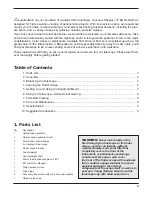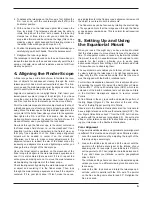
7
Aiming the Telescope
To view an object in the main telescope, first loosen both the
R.A. and Dec. lock knobs. Aim the telescope at the object you
wish to observe by “eyeballing” along the length of the tele-
scope tube (or use the setting circles to “dial in” the object’s
coordinates). Then look through the (aligned) finder scope and
move the telescope tube until the object is centered on the
crosshairs. Retighten the R.A. and Dec. lock bolts. Then cen-
ter the object on the finder’s crosshairs using the R.A. and Dec.
slow-motion controls. The object should now be visible in the
main telescope with a low-power (long focal length) eyepiece.
Focusing the Telescope
Practice focusing the telescope in the daytime before using it
for the first time at night. Start by positioning the focuser near
the center of its adjustment range. Make sure the knurled
focus lock knob on the top of the focuser housing is loosened,
to allow the drawtube to move freely. Insert an eyepiece into
the focuser and secure with the thumbscrew. Point the tele-
scope at a distant subject and get it in the field of view. Now,
slowly rotate one of the focusing knobs until the object comes
into sharp focus. Go a little bit beyond sharp focus until the
image just starts to blur again, then reverse the rotation of the
knob, just to make sure you hit the exact focus point. The tel-
escope can only focus on objects at least 50 to 100 feet away.
It will not focus without the star diagonal in place.
As with all refractor telescopes used with a standard 90° star
diagonal, the image you see will be right-side up, but
reversed left-to-right. (Correct-image diagonals are avail-
able, and may be purchased separately, though the image
quality is slightly reduced.)
Do You Wear Eyeglasses?
If you wear eyeglasses, you may be able to keep them on
while you observe, if your eyepieces have enough “eye relief”
to allow you to see the whole field of view. You can try this by
looking through the eyepiece first with your glasses on and
then with them off, and see if the glasses restrict the view to
only a portion of the full field. If they do, you can easily
observe with your glasses off by just refocusing the telescope
the needed amount.
Calculating the Magnification
It is desirable to have a range of eyepieces of different focal
lengths, to allow viewing over a range of magnifications. To calcu-
late the magnification, or power, of a telescope, simply divide the
focal length of the telescope by the focal length of the eyepiece:
Telescope focal length ÷ Eyepiece focal length =
Magnification (power)
For example, the Observer 70 EQ, which has a focal length
of 700mm, used in combination with a 25mm eyepiece, yields
a power of
700 ÷ 25 = 28x.
Every telescope has a useful limit of power of about 45x–60x per
inch of aperture (diameter of objective lens). Claims of higher
power by some telescope manufacturers are a misleading adver-
tising gimmick and should be dismissed. Keep in mind that at
higher powers, an image will always be dimmer and less sharp
(this is a fundamental law of optics). The steadiness of the air (the
“seeing”) will limit how much magnification an image can tolerate.
Always start viewing with your lowest-power (longest focal
length) eyepiece in the telescope. After you’ve located and
looked at the object with it, you can try switching to a higher-
power eyepiece to ferret out more detail, if atmospheric
conditions permit. If the image you see is not crisp and
steady, reduce the magnification by switching to a longer-
focal-length eyepiece. As a general rule, a small but
well-resolved image will show more detail and provide a more
enjoyable view than a dim and fuzzy, overmagnified image.
Camera Attachment
A 35mm single-lens reflex (SLR) camera body can easily be
attached to the Observer 70mm enabling you to take pictures
through the telescope. All that is needed is one additional
part, called a T-ring, which is specific to your model of cam-
era (see the Orion catalog for selection).
Remove the eyepiece and diagonal from the telescope opti-
cal tube. Also remove any lenses that may already be
attached to your camera body. Now, connect the T-ring to
your camera. The T-ring, with your camera attached, threads
directly onto the end of the telescope. When used in this con-
figuration, the Observer 70 acts as a 700mm telephoto lens
(the focal length of the telescope).
Let Your Eyes Dark-Adapt
Don’t expect to go from a lighted house into the darkness of
the outdoors at night and immediately see faint nebulas,
galaxies, and star clusters—or even very many stars, for that
matter. Your eyes take about 30 minutes to reach perhaps
80% of their full dark-adapted sensitivity. Many observers
notice improvements after several hours of total darkness. As
your eyes become dark-adapted, more stars will glimmer into
view and you’ll be able to see fainter details in objects you
view in your telescope. Exposing your eyes to very bright
daylight for extended periods of time can adversely affect
your night vision for days. So give yourself at least a little
while to get used to the dark before you begin observing.
To see what you’re doing in the darkness, use a red-filtered
flashlight rather than a white light. Red light does not spoil
your eyes’ dark adaptation like white light does. A flashlight
with a red LED light is ideal, or you can cover the front of a
regular incandescent flashlight with red cellophane or paper.
Beware, too, that nearby porch and street lights and car
headlights will ruin your night vision.
“Seeing” and Transparency
Atmospheric conditions vary significantly from night to night.
“Seeing” refers to the steadiness of the Earth’s atmosphere at
a given time. In conditions of poor seeing, atmospheric turbu-
lence causes objects viewed through the telescope to “boil.” If,
when you look up at the sky with just your eyes, the stars are
twinkling noticeably, the seeing is bad and you will be limited to
viewing with low powers (bad seeing affects images at high
powers more severely). Planetary observing may also be poor.
























